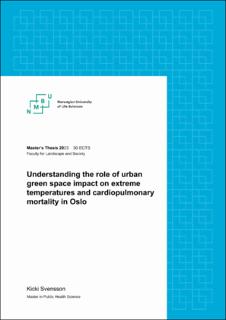| dc.description.abstract | Abstract
Background: The climate change contributes to increasing temperature and causes severe heatwaves; at the same time, we see increased urbanization worldwide. Every year many people die from cardiovascular disease (CVD) and respiratory disease (RD), in some places there is increased mortality due to extreme temperatures. The cities must adapt to climate change and prevent the health issues following. In many places nature-based solutions are implemented as climate adaption strategy, where green vegetation contributes to lower temperatures. In Norway we can expect more extreme temperatures in the future.
Objective: The aim with this study is to investigate if people living near urban green areas are protected against premature cardiopulmonary mortality in Norway’s capital and biggest city, Oslo.
Method: This study has used data from HUBRO cohort (Oslo Health survey), merged with temperature data and NDVI values at individual level. The study period is 1st January 2000 till 31st December 2018. Persons who died from all-cause mortality, ICD-10 code A00-R99 was extracted, it was created groups for CVD and RD mortality for the analysis. The method of case crossover using conditional logistic regression to estimate the effect of daily mean air temperature on cardiopulmonary mortality was used as statistical method. With use of lag days delayed outcome was captured. NDVI was used as an effect modifier, divided by the median, 0.43, in two categories. Both warm and cold effect was measured. Measures of association was produced in odds ratio (OR).
Main findings: The total number of participants was 3527 people from the HUBRO cohort who died in Oslo due to natural causes, 1070 people died due to CVD, and 302 due to RD. The analyze gave two statistically significant results: use of 3 lag days on warm effect the OR was 4.92 (95%CI: 1.48-16.4) for RD mortality, and in the interaction analysis CVD mortality had OR 4.82 (95%CI:1.6-14.43) on cold effect in areas with high NDVI. The other results in the interaction analysis indicate people living in areas with high NDVI have reduced risk of premature mortality due to CPD, none of those results showed statistical significance.
Conclusion: There was too few participants to get results with good precision. But the result indicates surrounding greenness have impact on CPD mortality in Oslo. There is need for further investigations on the health issues due to climate change in Oslo, and to investigate the use of nature-based solutions as climate adaption strategies to improve the public health in Oslo. | |
